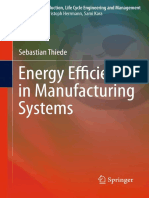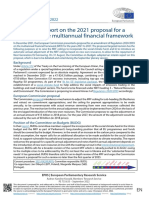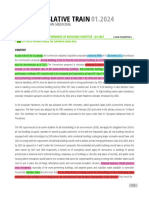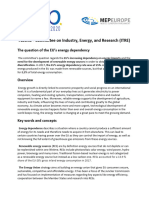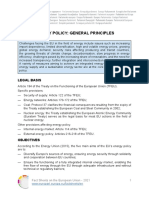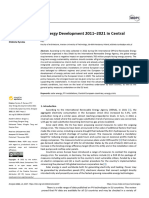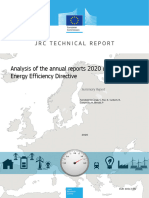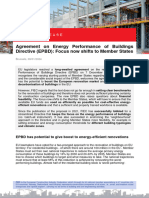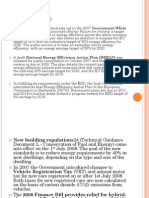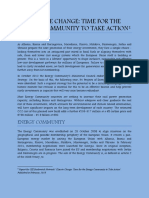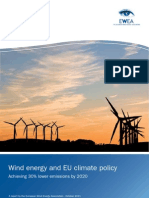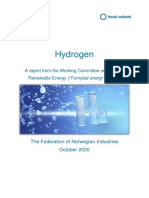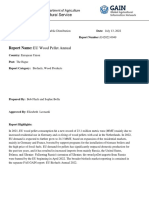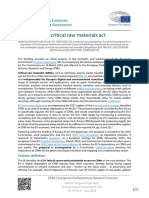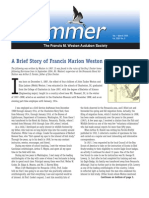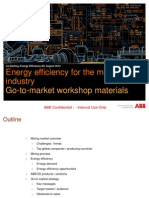Fit For 55
Fit For 55
Uploaded by
Kgjkg KjkgCopyright:
Available Formats
Fit For 55
Fit For 55
Uploaded by
Kgjkg KjkgOriginal Title
Copyright
Available Formats
Share this document
Did you find this document useful?
Is this content inappropriate?
Copyright:
Available Formats
Fit For 55
Fit For 55
Uploaded by
Kgjkg KjkgCopyright:
Available Formats
AT A GLANCE
Plenary – September 2022
Fit for 55 package: Energy Efficiency Directive
The September 2022 plenary session will debate a report from the Committee for Industry, Research and Energy
(ITRE) on the Commission's proposal to recast the Energy Efficiency Directive, as part of the 'fit for 55' package.
The vote on the report will set Parliament's position for trilogue negotiations with the Council.
Background
The European Commission adopted the 'fit for 55' package in July 2021, with the aim of adapting existing EU
climate and energy legislation to meet the new EU objective of a minimum 55 % reduction in greenhouse gas
(GHG) emissions by 2030, as required under the European Climate Law. The 'fit for 55' package includes a
recast of the Energy Efficiency Directive (EED), reworking its provisions to deliver greater energy savings. The
existing EED is largely designed around the target of a 40 % reduction in GHG emissions by 2030.
European Commission proposal
The Commission proposed a recast EED in July 2021 that would require Member States to almost double
their annual energy savings obligations (ESOs) from 2024 onwards, make exemplary efforts with binding
targets in the public sector, address energy poverty, and pursue other actions to deliver a collectively
binding obligation of 9 % more energy savings than envisaged under existing EU legislation. As part of the
REPowerEU plan (May 2022) to address the energy crisis caused by the Russian invasion of Ukraine, the
Commission proposed a targeted amendment of the EED that would require 13 % more energy savings by
2030, setting upper limits on final and primary energy consumption of 750 and 980 Mtoe respectively.
Council position
The Council of the EU adopted a general approach in June 2022 that supports the original targets proposed
by the Commission in July 2021: upper limits on final and primary energy consumption of 787 Mtoe and
1023 Mtoe respectively. National contributions would remain indicative (non-binding) and based
exclusively on final (not primary) energy consumption. Targets for renovating public buildings would only
become binding after four years and be limited to buildings owned by public bodies. The increase in annual
ESOs would be more gradual than in the Commission proposal, rising in steps from 1.1 % (2024-2025) to
1.5 % (2028-2030), and allowing greater flexibility in accounting between years.
European Parliament position
The ITRE committee adopted a report in July 2022 that sets more ambitious targets, equivalent to a 40 %
reduction in final energy consumption (upper limit of 740 Mtoe) and a 42.5 % reduction in primary energy
consumption (upper limit of 960 Mtoe). Member States would need to deliver binding national
contributions based on both indicators of energy consumption, and would need to meet milestones in 2025
and 2027 to ensure they are on track. The ITRE report contains more ambitious targets for the public sector
than those proposed by the Commission and the Council, covering buildings owned and rented by public
bodies. The ITRE report proposes annual ESOs of 2 % final energy consumption between 2024 and 2030, a
third higher than the Commission's proposal (1.5 %). It also provides considerably more detail on
implementing the 'energy efficiency first' principle, addressing energy poverty, monitoring energy use of
data centres, establishing 'one stop shops' on energy efficiency, and developing energy partnerships.
First-reading report: 2021/0203(COD); Committee
responsible: ITRE; Rapporteur: Niels Fuglsang (S&D, Denmark).
For further information, see our 'EU Legislation in progress'
briefing.
EPRS | European Parliamentary Research Service
Author: Alex Wilson, Members' Research Service
PE 733.627 – September 2022
This document is prepared for, and addressed to, the Members and staff of the European Parliament as background material to assist them in
their parliamentary work. The content of the document is the sole responsibility of its author(s) and any opinions expressed herein should not
be taken to represent an official position of the Parliament. Reproduction and translation for non-commercial purposes are authorised, provided
the source is acknowledged and the European Parliament is given prior notice and sent a copy. © European Union, 2022 EN
eprs@ep.europa.eu (contact) http://www.eprs.ep.parl.union.eu (intranet) http://www.europarl.europa.eu/thinktank (internet) http://epthinktank.eu (blog)
You might also like
- Draft of New Electricity Bill Sri LankaDocument93 pagesDraft of New Electricity Bill Sri LankaAdaderana OnlineNo ratings yet
- Energy Efficiency in Manufacturing Systems (2012) PDFDocument213 pagesEnergy Efficiency in Manufacturing Systems (2012) PDFNavamaniSp100% (1)
- Kilowatt Ours CurriculumDocument82 pagesKilowatt Ours CurriculumTracy Perone100% (1)
- Eprs Ata (2022) 733633 enDocument1 pageEprs Ata (2022) 733633 enKgjkg KjkgNo ratings yet
- CELEX_52022DC0547_EN_TXTDocument26 pagesCELEX_52022DC0547_EN_TXTmouzuoyeNo ratings yet
- Directive (Eu) 2023-1791 enDocument111 pagesDirective (Eu) 2023-1791 enZvonko DamnjanovićNo ratings yet
- Background Paper NZEBDocument25 pagesBackground Paper NZEBsteinman1No ratings yet
- State of the Energy Union Report 2024Document21 pagesState of the Energy Union Report 2024mouzuoyeNo ratings yet
- EED - EC ProposalDocument132 pagesEED - EC ProposalwvsqcbcvbvNo ratings yet
- EU China Energy Magazine 2022 Christmas Double Issue: 2022, #11From EverandEU China Energy Magazine 2022 Christmas Double Issue: 2022, #11No ratings yet
- 2018 2002 EuDocument21 pages2018 2002 EuAritra DasguptaNo ratings yet
- A European Green Dealrevision of The Energy Performance of Buildings Directivea European Green Deal A European Green Deal7701Document3 pagesA European Green Dealrevision of The Energy Performance of Buildings Directivea European Green Deal A European Green Deal7701Ezra solomonNo ratings yet
- EU China Energy Magazine 2022 Summer Double Issue: 2022, #6From EverandEU China Energy Magazine 2022 Summer Double Issue: 2022, #6No ratings yet
- 6.a. ITRE_FactFile iMEP Stockholm 2020Document3 pages6.a. ITRE_FactFile iMEP Stockholm 2020Matvij DrulNo ratings yet
- RAPORT CE Dec 2019 - Renovarea Cladirilor in UEDocument89 pagesRAPORT CE Dec 2019 - Renovarea Cladirilor in UETroi LauraNo ratings yet
- REDIIDocument55 pagesREDIIMadalina GrigorescuNo ratings yet
- EU Energy Policy PrinciplesDocument8 pagesEU Energy Policy PrinciplesCimnaz IsmayilovaNo ratings yet
- Commission Communication 2013-762 - Implementing The Energy Efficiency Directive - Commission Guidance (En)Document9 pagesCommission Communication 2013-762 - Implementing The Energy Efficiency Directive - Commission Guidance (En)iurii socolNo ratings yet
- Oj:l 202302413:en:txt-13Document77 pagesOj:l 202302413:en:txt-13b6np69tshvNo ratings yet
- RefuelEU AviationDocument1 pageRefuelEU AviationKgjkg KjkgNo ratings yet
- Rexel International Regulation Review June 2011Document3 pagesRexel International Regulation Review June 2011Energy 3.0No ratings yet
- REPowerEU - A PlanDocument5 pagesREPowerEU - A PlansamNo ratings yet
- RES Directive SpecialDocument4 pagesRES Directive SpecialNaciye TengilimoğluNo ratings yet
- EWEA Aiming HighDocument40 pagesEWEA Aiming HighMatt MaceNo ratings yet
- Research: Committee On Industry, Research and Energy (ITRE)Document5 pagesResearch: Committee On Industry, Research and Energy (ITRE)GeorgiaStefanNo ratings yet
- 4 Review of PV Solar Energy Development 2011 2021 in Central European CountriesDocument18 pages4 Review of PV Solar Energy Development 2011 2021 in Central European Countrieskiettt2108No ratings yet
- Energies 13 04261 v2Document31 pagesEnergies 13 04261 v2h3493061No ratings yet
- Commission of The European CommunitiesDocument32 pagesCommission of The European Communitiesrobnet-1No ratings yet
- Energy Transition in The EUDocument10 pagesEnergy Transition in The EUfds87No ratings yet
- Proposal Recast Energy Performance Buildings DirectiveDocument79 pagesProposal Recast Energy Performance Buildings DirectiveThiago PresaNo ratings yet
- EU China Energy Magazine 2021 Christmas Double Issue: 2021, #4From EverandEU China Energy Magazine 2021 Christmas Double Issue: 2021, #4No ratings yet
- Analysis of The Annual Reports 2020 Under The energy-KJNA30517ENNDocument56 pagesAnalysis of The Annual Reports 2020 Under The energy-KJNA30517ENNnikoskasim1970No ratings yet
- EU China Energy Magazine 2022 October Issue: 2022, #8From EverandEU China Energy Magazine 2022 October Issue: 2022, #8No ratings yet
- 1 en Act Part1 v16 PDFDocument22 pages1 en Act Part1 v16 PDFMatevz PusnikNo ratings yet
- EN EN: European CommissionDocument24 pagesEN EN: European Commissionandrea bottazziNo ratings yet
- Hydrogen Strategy PDFDocument24 pagesHydrogen Strategy PDFAlper KzNo ratings yet
- 11 AnnextoEPLetterEPBDfinaltext ENDocument146 pages11 AnnextoEPLetterEPBDfinaltext ENlucaroscianiNo ratings yet
- Passive Houses Legislation - Cons Cons (2010) 05386 (Rev3) enDocument71 pagesPassive Houses Legislation - Cons Cons (2010) 05386 (Rev3) enkaliagraNo ratings yet
- Red IiiDocument167 pagesRed Iiicjfelbol.4digital100% (1)
- Wind Energy ContributionDocument104 pagesWind Energy ContributionTown Obio EteteNo ratings yet
- Electricity Demand and Carbon Emission in Power Generation Under High Penetration of Electric Vehicles. A European Union PerspectiveDocument12 pagesElectricity Demand and Carbon Emission in Power Generation Under High Penetration of Electric Vehicles. A European Union PerspectivechopinaNo ratings yet
- 2024-01-09 - FIEC Press Release EPBD Agreement FINALDocument3 pages2024-01-09 - FIEC Press Release EPBD Agreement FINALpedmedeNo ratings yet
- Reformingthe EUElectricity MarketDocument11 pagesReformingthe EUElectricity Marketwindreader1No ratings yet
- Rish Olicies: Paper, Delivering A Sustainable Energy Future For Ireland, A TargetDocument4 pagesRish Olicies: Paper, Delivering A Sustainable Energy Future For Ireland, A TargetSeamus CreedNo ratings yet
- Energy Community BiHDocument23 pagesEnergy Community BiHIdaNo ratings yet
- Memo For Road Map of Renewable EnergyDocument4 pagesMemo For Road Map of Renewable EnergySaleh Al-TamimiNo ratings yet
- Ftu 2.4.7Document5 pagesFtu 2.4.77qswr2gw84No ratings yet
- EN EN: European CommissionDocument14 pagesEN EN: European CommissionLim ChintakNo ratings yet
- European Policies On Climate and EnergyDocument12 pagesEuropean Policies On Climate and EnergyanterogerNo ratings yet
- Energyunion Citizens Summary enDocument2 pagesEnergyunion Citizens Summary enCodrut GeorgescuNo ratings yet
- 2009 Eeap Background Document PDFDocument8 pages2009 Eeap Background Document PDFIgor NeagaNo ratings yet
- ClimateReportDocument40 pagesClimateReportgunturadijayaNo ratings yet
- Snapshot of Energy Efficiency ObligationDocument51 pagesSnapshot of Energy Efficiency ObligationkemredserbiaNo ratings yet
- Guidance Note On EPBD Building Modernisation, EC, 2019Document59 pagesGuidance Note On EPBD Building Modernisation, EC, 2019IvanJNo ratings yet
- Hydrogen Report From The Norwegian IndustryDocument11 pagesHydrogen Report From The Norwegian IndustryAlex SmithNo ratings yet
- Renewable Energy Snapshot: UkraineDocument4 pagesRenewable Energy Snapshot: UkraineUNDP in Europe and Central AsiaNo ratings yet
- 2014 Energy Efficiency CommunicationDocument27 pages2014 Energy Efficiency CommunicationkktayNo ratings yet
- EU-China Energy Magazine 2021 Summer Issue: 2021, #2From EverandEU-China Energy Magazine 2021 Summer Issue: 2021, #2No ratings yet
- Renewable Electricity Corporate Power Purchase Agreements RoadmapDocument19 pagesRenewable Electricity Corporate Power Purchase Agreements RoadmapHarshita DixitNo ratings yet
- 2023 - EU - Energy Performance of Buildings - UpdatedDocument128 pages2023 - EU - Energy Performance of Buildings - Updatedheerali singhNo ratings yet
- EU Wood Pellet Annual - The Hague - European Union - E42022-0049Document13 pagesEU Wood Pellet Annual - The Hague - European Union - E42022-0049Nadya Izzatul ZahraNo ratings yet
- Renewable Energy in EuropeDocument23 pagesRenewable Energy in EuropeAnil KunworNo ratings yet
- EU China Energy Magazine 2024 August Issue: 2024, #3From EverandEU China Energy Magazine 2024 August Issue: 2024, #3No ratings yet
- EU Critical Raw Materials ActDocument8 pagesEU Critical Raw Materials ActKgjkg KjkgNo ratings yet
- Ozone RegulationDocument10 pagesOzone RegulationKgjkg KjkgNo ratings yet
- Co2 Emission StandardsDocument10 pagesCo2 Emission StandardsKgjkg KjkgNo ratings yet
- Beyond GrowthDocument128 pagesBeyond GrowthKgjkg KjkgNo ratings yet
- Product LiabilityDocument12 pagesProduct LiabilityKgjkg KjkgNo ratings yet
- Ipol Stu (2022) 734004 enDocument68 pagesIpol Stu (2022) 734004 enKgjkg KjkgNo ratings yet
- Eprs Bri (2022) 739271 enDocument17 pagesEprs Bri (2022) 739271 enKgjkg KjkgNo ratings yet
- Ipol Stu (2020) 655135 (Sum01) enDocument4 pagesIpol Stu (2020) 655135 (Sum01) enKgjkg KjkgNo ratings yet
- Eprs Ata (2022) 733520 enDocument2 pagesEprs Ata (2022) 733520 enKgjkg KjkgNo ratings yet
- Inancing Reception CostsDocument1 pageInancing Reception CostsKgjkg KjkgNo ratings yet
- Human GenomsDocument2 pagesHuman GenomsKgjkg KjkgNo ratings yet
- Family PatternsDocument1 pageFamily PatternsKgjkg KjkgNo ratings yet
- CoalDocument2 pagesCoalKgjkg KjkgNo ratings yet
- Onthly HighlightsDocument2 pagesOnthly HighlightsKgjkg KjkgNo ratings yet
- Oil-Free Rotary Screw Compressors: ZR 300-750 & ZR 400-900 VSDDocument16 pagesOil-Free Rotary Screw Compressors: ZR 300-750 & ZR 400-900 VSDElsa Dewi100% (2)
- Pa 00 KGTJDocument176 pagesPa 00 KGTJshaikhsalmanahmed0No ratings yet
- 7 National Certification Examination FOR Energy Auditors - Nov., 2008Document8 pages7 National Certification Examination FOR Energy Auditors - Nov., 2008venkatraman1985No ratings yet
- Energy Efficiency: Sustainable Energy Regulation and Policy-Making For AfricaDocument44 pagesEnergy Efficiency: Sustainable Energy Regulation and Policy-Making For Africakuye dejiNo ratings yet
- KTR - Cooling SystemDocument42 pagesKTR - Cooling SystemMarceloGonçalvesNo ratings yet
- A Brief Story of Francis Marion Weston: Feb.-March 2008 Vol. XXXIV No. 5Document8 pagesA Brief Story of Francis Marion Weston: Feb.-March 2008 Vol. XXXIV No. 5Francis M. Weston Audubon SocietyNo ratings yet
- FYP SnopsisDocument11 pagesFYP Snopsisynadeem.mscs24seecsNo ratings yet
- The ProblemDocument31 pagesThe ProblemPrincess Arielle KintanarNo ratings yet
- Data Centre DCOMDocument17 pagesData Centre DCOMMarco Tulio Holguín TapiaNo ratings yet
- Abdlemalik MohammedDocument82 pagesAbdlemalik MohammedtmmNo ratings yet
- Griha: Green Rating For Integrated Habitat AssessmentDocument23 pagesGriha: Green Rating For Integrated Habitat AssessmentsweetloverzNo ratings yet
- How To Stop Climate Change Mrugesh RasalDocument11 pagesHow To Stop Climate Change Mrugesh RasalKamran AkmalNo ratings yet
- Introduction To Artificial Intelligence in Power Stations: by Darshan MsDocument10 pagesIntroduction To Artificial Intelligence in Power Stations: by Darshan Msvinayakams591No ratings yet
- Mining Industry Energy Efficiency WorkshopDocument112 pagesMining Industry Energy Efficiency WorkshopHugo Ramon Saravia Campelli0% (1)
- Electrical Consumption of AppliancesDocument3 pagesElectrical Consumption of AppliancesgtgreatNo ratings yet
- Iare EAM Lecture NotesDocument67 pagesIare EAM Lecture NotesSaikumar NemalikantiNo ratings yet
- KBT Singapore Firsts Green Mark Platinum Zero Energy Commerical BuildingDocument25 pagesKBT Singapore Firsts Green Mark Platinum Zero Energy Commerical BuildingRavuth SimNo ratings yet
- Climate Change Energy Mediterranean enDocument572 pagesClimate Change Energy Mediterranean enAseel Abu Daba'tNo ratings yet
- Renewable Energy: Ehsan Mohseni, Waiching TangDocument13 pagesRenewable Energy: Ehsan Mohseni, Waiching Tangmahdi najafzadehNo ratings yet
- Eco System Green Logistics: Level: Basics On Technology, Innovation, Social and Ecnomic ImpactsDocument32 pagesEco System Green Logistics: Level: Basics On Technology, Innovation, Social and Ecnomic ImpactsBudmed GanbaatarNo ratings yet
- CASINI Smartbuildings SummaryDocument23 pagesCASINI Smartbuildings SummaryNatalia BeldaNo ratings yet
- Electric Machines and Drives PDFDocument278 pagesElectric Machines and Drives PDF@ngg@ngNo ratings yet
- Becm 0129Document6 pagesBecm 0129crhlsrNo ratings yet
- Jacque Fresco EssaysDocument18 pagesJacque Fresco EssaysDarklaykNo ratings yet
- Environmentally Sustainable Design ReportDocument52 pagesEnvironmentally Sustainable Design ReportCivilEngClubNo ratings yet
- Miami Beach RFP Review 2022 FINALDocument9 pagesMiami Beach RFP Review 2022 FINALthe next miamiNo ratings yet
- JCI - Net Zero in IndiaDocument26 pagesJCI - Net Zero in IndiaAmrit RajNo ratings yet

